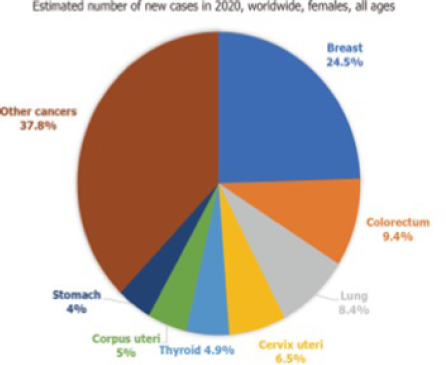Translate this page into:
Indian solutions for Indian problems - Breast cancer

*Corresponding author: Somashekhar SP, Global Director, Aster International Institute of Oncology, Bangalore, India. somusp@yahoo.com
-
Received: ,
Accepted: ,
How to cite this article: Somashekhar SP. Indian solutions for Indian problems - Breast cancer. Indian J Breast Imaging 2023;1:4-5.
Breast Cancer (BC) is expected to reach almost 2 million by 2030.[1] As per the Globocan data 2020, in India, BC accounted for 13.5% (1,78,361) of all cancer cases and 10.6% (90,408) of all deaths, with a cumulative risk of 2.81 [Figure 1]. In India 2018, breast cancer accounted for 27.7% of all newly detected cancers in women, demonstrating the massive disease burden. Therefore, India-specific solutions for early detection, treatment, and preventive strategies are paramount. The five essential recommendations are summed up below:
-
The point-of-care Breast Imaging device (iBreastExam) has demonstrated significant sensitivity (19%), specificity (94%), and NPV (98%) than CBE (Clinical Breast Examination) to detect breast lesions. It is a handy tool for younger patients (below 40 years). In these women, the breast tissues are highly dense, and CBE could lead to misdiagnosis. iBreastExam can detect all malignant lesions and is an ideal tool for India to detect breast lesions at early stages. It is a clinically effective and standardized breast examination tool in low-resource settings.[2]
-
Indocyanine green (ICG) is an alternative to blue dye, and this radio-colloid method of SLNB (Sentinel Lymph Node Biopsy) is useful. ICG fluorescence imaging is ideal for India. It permits real-time visualization of lymphatics and provides an additional dimension to SLNB that is safe and effective. It does not require a nuclear medicine department. ICG can reliably replace dual dye and be employed as a sole tracer for SLNB in early breast cancer.[3]
-
CanAssist-Breast (CAB) is an immunohistochemistry (IHC)-based prognostic test for early-stage hormone receptor (HR+)-positive breast cancer patients. CAB uses a Support Vector Machine (SVM) trained algorithm that utilizes expression levels of five biomarkers (CD44, ABCC4, ABCC11, N-Cadherin, and Pan-Cadherin) and three clinical parameters such as tumor size, grade, and node status as inputs to generate a risk score and categorizes patients as low- or high-risk for distant recurrence within five years of diagnosis. CAB should be routinely used to evaluate disease progression.[4]
-
Apart from diagnostic and treatment tools, there is a need for trained, competent medical professionals. The field of breast oncology needs to progress further, and training of general surgeons in handling surgical procedures for breast cancer is necessary. Association of Breast Surgeons of India (ABSI) has developed a training module for surgeons, practical guidelines, and consensus recommendations for early detection and treatment of breast cancer in India.[5]
-
The use of technology is essential, and one must not shy away from using it. It is recommended to use artificial intelligence (AI) clinical decision-support systems (CDSSs) to finalize the treatment modality considered by the tumor board. AI technology has demonstrated that the AI-based clinical decision-support system is helpful for breast cancer treatment decision-making, especially at centers where expert breast cancer resources are limited, such as India. This technology can help resolve the treating clinician’s dilemma in planning a personalized treatment for the patient. The technology provides scientific evidence, the status of drug approvals, and treatment guidelines. The patient can still receive appropriate treatment without specialists and can benefit from the same.[6]

- A visual representation of estimated number of new cases in 2020, worldwide, females, all ages.
Acknowledgment
The author would like to thank Dr. Manjusha R for providing help in editing.
References
- International Agency for Research on Cancer. India Source: Globocan 2020. Available from: https://gco.iarc.fr/today/data/factsheets/populations/356-india-fact-sheets.pdf [Last accessed on 2021 June 11].
- Noninvasive and low-cost technique for early detection of clinically relevant breast lesions using a handheld point-of-care medical device (iBreastExam): Prospective three-arm triple-blinded comparative study. Indian J Gynecol Oncolog. 2016;14:26.
- [Google Scholar]
- Can low-cost indo cyanine green florescence technique for sentinel lymph node biopsy replace dual dye (radio-colloid and blue dye) technique in early breast cancer: A prospective two-arm comparative study. Clin Breast Cancer. 2020;20:e576-e583.
- [CrossRef] [PubMed] [Google Scholar]
- CanAssist breast impacting clinical treatment decisions in early-stage HR+ breast cancer patients: Indian scenario. Indian J Surg Oncol. 2021;12:21-29.
- [CrossRef] [PubMed] [PubMed Central] [Google Scholar]
- Association of Breast Surgeons of India (ABSI) practical consensus statement, recommendations, and guidelines for the treatment of breast cancer in India 2021—Indian solutions for Indian problems. Indian J Surg. 2022;84:573-584.
- [Google Scholar]
- 1674PExploratory study of CK-M30 and pHH3 expression in Circulating Tumor Cells (CTCs) as biomarkers of docetaxel (DOC) efficacy in metastatic castration resistant prostate cancer (mCRPC) Annals of Oncology. 2017;28
- [Google Scholar]







